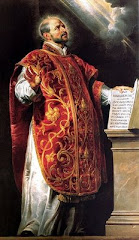
What is the meaning of the cross of our Lord? What does it mean that even on the cross the prayer of Jesus was rejected by his Father, that he sent up a prayer and it could not pierce the clouds, but turned around and was hurled back in his face? I want to offer two reflections.
The first thought is stimulated by the oldest image of the crucifixion known to us. It is the famous graffiti from between 69-98 AD, in the Palatine museum.
This "graffito," scratched into the plaster on the side of a building in Rome, dates from about 250 AD. The hastily made image (probably by a teenager in those days) shows a crucifix with a donkey's head, seen from behind and dressed in a short tunic. To the left stands a young man with the same clothes and his arm raised. Between the two figures are the words in Greek: "Alexamenos sebete theon" ("Alexamenos worships his god"). Apparently, the author of the drawing is making fun of a Christian, Alexamenos, who is praying to a crucified god with a donkey's head. The Y visible on the plaster, to the right at the top, has been interpreted as a symbol of a gallows, or a transcription of a scream of pain.
Yes, the very earliest image of the crucified Jesus is a parody, with an ass' head. There is a stick on the top with a piece of paper naming the crime of the person being punished, common in crucifixions. Possibly a footstool, or feet on the ground, or just off the ground, or with a seat on the cross to keep him from dying too quickly. The boy on the side is making a gesture of acclamation with his hand. The inscription in Greek, “Alexamenos worships God.” One school boy mocking another by saying he is worshiping a crucified God. This is the only representation we have before 400AD, and it is not done by a Christian. When I first learned this my reaction was a mixture of being stunned and consoled. Yes, this is what I worship. This is who I follow. I follow a crucified God, a failure. My symbol was first inscribed in stone forever as a mockery, as the symbol of the failure of my God. Do I have the courage to worship the God of Alexamenos, a God who died, naked, a spectacle before the world?
My second thought comes from the diary of Pierre Favre. Pierre Favre, one of the first three original companions of the Society of Jesus wrote these words in his diary on February 21, the Saturday after Ash Wednesday. One of the most beautiful of the early writings of Jesuits, the interior depth and spiritual sensitivity of Favre is richly expressed in his meditation:
On the same day towards evening, as I was leaving the king's palace, I found myself in the presence of a large group of mounted men drawn up to receive some general. This had attracted a huge crowd, as if for a great and splendid spectacle. I withdrew into a church nearby to escape the concourse and the tumult. While inside the church, I felt impelled by some curiosity to go out again and gaze at what I had just come inside to avoid. At that moment I looked up at a crucifix and that impulse of curiosity ceased at once. With tears I have thanked my God for granting me the sight of this image, and I have sensed that the truly comforting spectacle is this: the memory that God almighty willed to take a body and to lay it aside in the sight of all the people, hanging between two robbers.
Those who long to gaze on what is around them, let them gaze on this sight; let the insatiable appetites of the eyes, the ears, and the other senses be assuaged here. If you cannot yet penetrate deeply enough to find peace there, continue the quest; for one simple desire, one hard-won impulse of curiosity for that sight is better than the enjoyment offered to our eyes by all the other spectacles to be seen in the world. For if Mary has not been allowed to enter the holy sepulcher, let her not for this reason cease to stand outside the tomb and weep.
This is our place. Let is not move from here, from outside this tomb that encloses the life of the world. What good can life be to us without him?
Markel, SJ


















1 comment:
nicely done!
Post a Comment